Age of Empires 4 stands at a crossroads. In many ways, it worships at the feet of its past, clinging to series history like a lord their land. But in others, it gazes into the horizon at a greater destiny ready for the taking, should it grow unafraid to seize it.
Calling Age of Empires 4 an Age of Empires 2 reboot would be easy enough. Similarly exploring the medieval period, and even some of the same battles, AoE 4 employs familiar mechanics found in that beloved 1999 entry and its expansions. After several remasters, new DLC releases, various developer updates, and wonderful support from the community, AoE 2 remains the standard-bearer of the franchise, with AoE 4 acting as its page.
That isn’t to say Age of Empires 4 fails; it certainly does not. More so, it’s to acknowledge Age 4 doesn’t fully seize its destiny — at least not so close to launch.
Age of Empires 4 Review: The Page of Kings
Age of Empires 4 has a solid foundation to build upon in the years to come. The campaign mode is the best and most engaging it’s ever been. Four of the eight available civilizations are represented in the mode: the English, French, Mongols, and Rus. Each campaign has a series of missions (35 in total) that focus on key historical conflicts, such as the Battle of Hastings or the Battle of Kalka River.
Each campaign becomes increasingly complex the further you fight through the ages, and each can take a few hours to complete depending on your skill and chosen difficulty.
As a long-time Age player, I can’t help but wish there were campaigns for each of the eight civilizations at launch. The Holy Roman Empire, Chinese, Delhi Sultanate, and Abbassid Dynasty are left out. But the breadth of the mode blunts that blow, even if we’ve seen some of these engagements before.
The best parts are the brief but in-depth “Hands on History” educational videos. Shot documentary-style and on location, these expertly filmed, produced, and narrated shorts are immersive and engaging in ways the old-style history pages could never be.
Relic Entertainment takes things a step further by superimposing animations of soldiers and siege engines on real-world locations, imbuing these annals with History-Channel-infused grandiosity that will fill fans with glee.
Alongside these videos are others that give insight into various middle-age building and crafting techniques, as well as lifestyle activities. One explores the painstaking process of crafting chainmail, and another examines the role of hawking and falconry in Norman culture. For history buffs — and who plays Age of Empires that isn’t? — there’s no retreating to parchment in future installments.
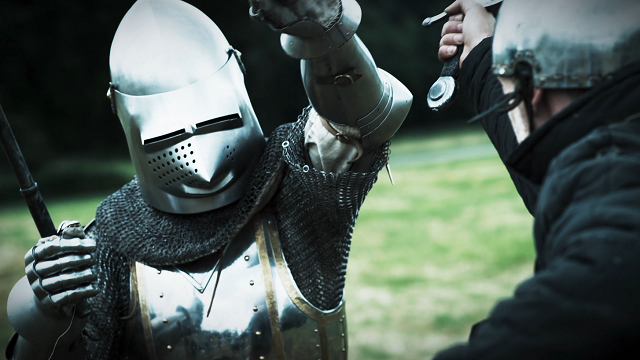
Outside of the campaign mode, it’s no surprise that skirmish and multiplayer modes make their returns. You select your civilization, teams, victory conditions, and map from 17 varied choices that randomly generate topography and resources. Nicely, there’s a map seed generator that allows you to capture and replay specific map layouts in future games.
As for other, more granular options, you won’t find the likes of turbo mode, sudden death, or regicide here. There’s no option to open the full tech tree from the start, post-imperial age isn’t available yet, you can’t bump the population above 200, and infinite resources has been swapped out for high resources.
I’m not particularly fussed about all of that — even if it seems regressive — and I imagine most players won’t be either. It does, however, highlight a grander overall point: there’s currently less in Age of Empires 4 than in other currently-available games in the franchise.
Perhaps most baffling is the absence of a map or scenario editor at launch. Editing maps and creating custom scenarios is baked into the DNA of Age of Empires, so it’s rightfully a point of contention.
Countless players have spent thousands of hours customizing skirmishes and campaigns over the decades, making incredible experiences shared by the wider Age community and acting as engines by which the franchise has stayed alive and improved. There may have never been an Age 2: DE without such modes.
To be fair, it seems like those tools are coming in 2022.
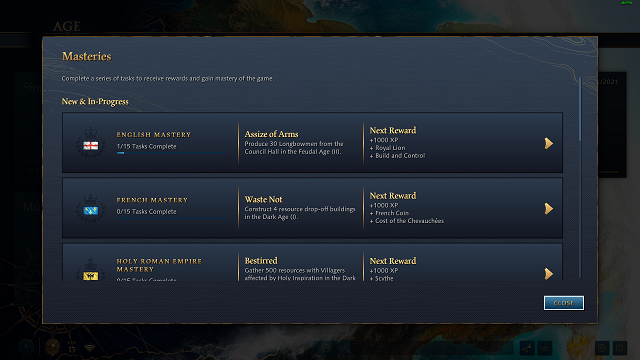
Some additions, though, seek to adjust or refine the familiar formula to varying degrees of success.
Masteries are one of those, and they’re all about bragging rights. These in-game challenges and achievements ask you to complete various tasks for each civilization, such as beating the hardest A.I. in Skirmish mode or producing a certain number of units from Keeps. There are 15 Masteries for each nation, gifting you rewards in experience, player portraits, banner designs, and more for your player card.
The rub is that Masteries can’t be completed in any order; instead, they must be completed sequentially, and their hierarchy is haphazard at best.
For example, killing 10 enemy units with Galeasses affected by the Armored Hull technology for the French isn’t so tricky, but it’s only available after Test of Strength III, which requires beating the A.I. on hard in Skirmish mode. Some players won’t find this problematic, but others will simply be locked out of rewards because accomplishing the latter isn’t attractive or just plain unattainable.
There’s also a level system at play, greeting you front and center on the main screen after completing the mandatory tutorial. Experience for this system comes from completing Masteries and daily quests (more in-game challenges not tied to Masteries). But that experience level doesn’t matter beyond showing other players in multiplayer lobbies that you’ve attained a certain level.
Experience isn’t used for purchasing items or unlocking new Masteries, maps, or units. It just exists. For those after a purely single-player experience, it serves no function whatsoever, and I can’t help but think time and effort could have been spent elsewhere.
Adding in a map or scenario editor, perhaps?

Mechanically, Age of Empires 4 plays like a mixture of Age of Empires 2 and Age of Empires 3. Advancing from the Dark Age to the Imperial Age, you build villagers, military units, and structures at a blistering pace to gather resources and take control of land faster than your opponent.
From combat to trade, many systems are familiar instantly, and this is where Age of Empires 4 doesn’t really need to iterate very much. The franchise has honed its gameplay to a fine point.
Grouping returns, which allows you to select units for the creation of regiments of any unit type. The system is perfect for sieges, flanking, or bump and run aggression. Stealth forests take a cue from the stealth mechanics found in AoE 3: The Warchiefs and allow you to place units in certain areas out of enemy sightlines.
Wall battles make sieges both flashier and more engaging, whereby swordsmen and spearmen can now attack archers and other units by way of siege towers or infiltrating gates and guard towers.
Neatly, rank and file soldiers can now build battering rams and siege towers in the field, using them as Trojan Horses to approach embattlements. No longer must you send engines ahead without protection lest troops be cut down by arrows. Soldiers can hide inside, exit to battle nearby enemy units, and retreat to cover while remaining on the front lines.
Landmarks tweak the familiar aging-up mechanic, and like Age 3, bypass the need for building a certain number of structures to move on to the next epoch. These Landmarks are like little wonders; they can be built as soon as you have the resources to do so, and each has unique buffs and rewards, such as having the ability to heal nearby units or reduce the cost of all technologies throughout the ages.
It’s a tangible improvement I appreciate over the more removed nature of politicians in AoE 3 or the drudgery of building structures for the sake of it in Age 2.
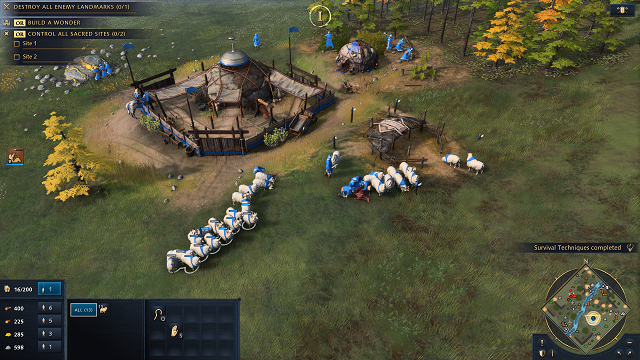
Perhaps one of the more exciting parts of Age of Empires 4 is the inclusion of asymmetric nations in the Mongols, Chinese, Rus, and Delhi Sultanate.
Mirroring their true pastoral nomadic lifestyle, the Mongols can pack up and move all of their buildings at will. They also have access to the Ovoo, a building that automatically collects stone, freeing up villagers for other tasks. They don’t have access to farms or farming technology, so they rely on pastures and sheep.
When aging up, the Chinese employ dynasties with buffs and unlocks, calling to mind Home City Shipments in Age of Empires 3. They also have Imperial Officials, which collect gold from buildings, subsidizing the need for gold mines. The biggest hurdle with the Chinese is that they must build both Landmarks to move on to the next dynasty and open up more buildings, units, and techs.
The Rus have unique relationships with resources. They can generate gold from hunting cabins placed near dense forests. More trees equate to more money over time, though building too many in close proximity decreases that yield. This dynamic creates new stratagems around Lumber Camps to push players further from their bases than they usually would venture.
The Delhi Sultanate doesn’t need resources to research technologies, but progress is painstaking. To boost this and military production, they employ Scholars, garrisoning them in various buildings for speed boosts.
And the Abbasid Dynasty takes an entirely different approach when advancing to the next age by building a singular Landmark, the House of Wisdom, and attaching different wings to advance and research new technologies.
All told, there are many unique elements with these civilizations that open up numerous tactic/counter-tactic playstyles. And despite the learning curves each of these factions presents, it’s in using them that the true potential of Age of Empires 4 shines brightest.
Age of Empires 4 Review — The Bottom Line
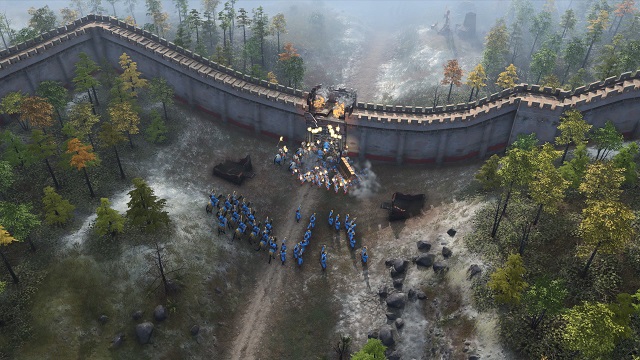
Pros
- Stunning “Hands on History” documentary-style campaign videos
- Improvements to siege mechanics
- Improvements to building and combat animations
- Addition of stealth forests
- Asymmetric civilizations
- Familiar gameplay
Cons
- Familiar gameplay
- No map or scenario editor at launch
- Over-emphasis on cosmetics
- Pointless experience system
- Unbalanced Mastery challenges
- Water-color art style is muddy in places
- Long load times in Skirmish mode
Age of Empires 4 does a lot of things right, but it curiously gets knocked off its horse when it could be champion of the tourney.
New asymmetric civilizations with unique units and compelling mechanics create new strategies in a land well-trodden. Add in the adjustments to siege warfare, modified systems for aging up, and the inclusion of stealth forests, and there’s the start of something here, perhaps something that could grow to be as impressive as Age of Empires 2.
But there’s also a general feeling that Age of Empires 4 doesn’t quite know what it wants to be yet or who it wants to cater to. Putting so much focus at launch on multiplayer is perfectly fine, but it also leaves some long-time single-player fans cold, especially with the exclusion of a map or scenario editor.
Notwithstanding the tremendously engaging educational elements of the campaign, having only four civilizations playable in that mode at launch seems like missed potential, even if, historically, we’ve never gotten scenarios for all of the civs from the start.
I’ve enjoyed my time with Age of Empires 4 quite a bit, and I’d recommend it to any Age fan. But I wouldn’t do so without a few important caveats. Age of Empires 4 may finally be available after 16 years, but it hasn’t arrived just yet. There are still resources to gather and troops to assemble.
[Note: Microsoft provided the copy of Age of Empires 4 used for this review.]

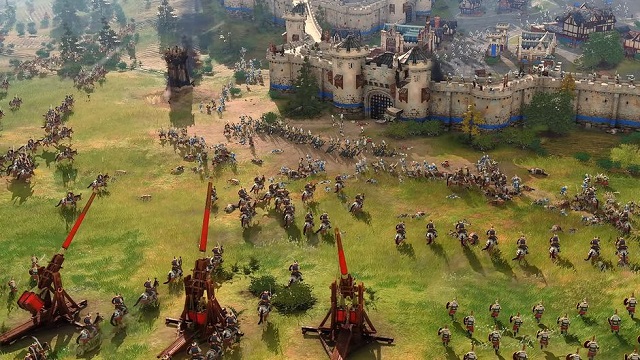








Published: Nov 19, 2021 05:45 pm